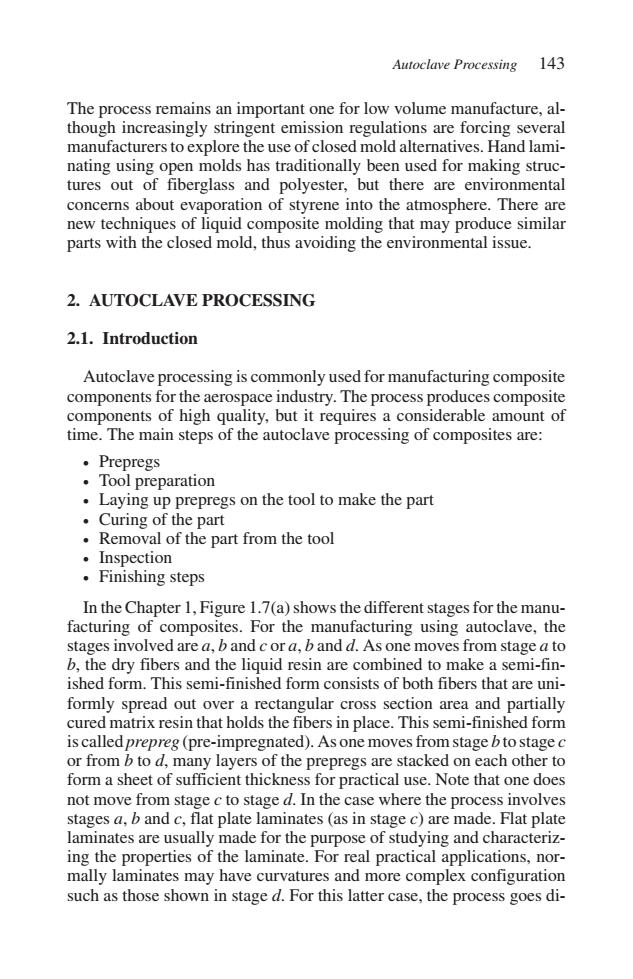正在加载图片...

Autoclave Processing 143 The process remains an important one for low volume manufacture,al- though increasingly stringent emission regulations are forcing several manufacturers to explore the use of closed mold alternatives.Hand lami- nating using open molds has traditionally been used for making struc- tures out of fiberglass and polyester,but there are environmental concerns about evaporation of styrene into the atmosphere.There are new techniques of liquid composite molding that may produce similar parts with the closed mold,thus avoiding the environmental issue. 2.AUTOCLAVE PROCESSING 2.1.Introduction Autoclave processing is commonly used for manufacturing composite components for the aerospace industry.The process produces composite components of high quality,but it requires a considerable amount of time.The main steps of the autoclave processing of composites are: ·Prepregs ·Tool preparation Laying up prepregs on the tool to make the part ·Curing of the part Removal of the part from the tool ·Inspection 。Finishing steps In the Chapter 1,Figure 1.7(a)shows the different stages for the manu- facturing of composites.For the manufacturing using autoclave,the stages involved are a,b and c or a,b and d.As one moves from stage a to b,the dry fibers and the liquid resin are combined to make a semi-fin- ished form.This semi-finished form consists of both fibers that are uni- formly spread out over a rectangular cross section area and partially cured matrix resin that holds the fibers in place.This semi-finished form is called prepreg(pre-impregnated).As one moves from stage bto stage c or from b to d,many layers of the prepregs are stacked on each other to form a sheet of sufficient thickness for practical use.Note that one does not move from stage c to stage d.In the case where the process involves stages a,b and c,flat plate laminates (as in stage c)are made.Flat plate laminates are usually made for the purpose of studying and characteriz- ing the properties of the laminate.For real practical applications,nor- mally laminates may have curvatures and more complex configuration such as those shown in stage d.For this latter case,the process goes di-The process remains an important one for low volume manufacture, although increasingly stringent emission regulations are forcing several manufacturers to explore the use of closed mold alternatives. Hand laminating using open molds has traditionally been used for making structures out of fiberglass and polyester, but there are environmental concerns about evaporation of styrene into the atmosphere. There are new techniques of liquid composite molding that may produce similar parts with the closed mold, thus avoiding the environmental issue. 2. AUTOCLAVE PROCESSING 2.1. Introduction Autoclave processing is commonly used for manufacturing composite components for the aerospace industry. The process produces composite components of high quality, but it requires a considerable amount of time. The main steps of the autoclave processing of composites are: • Prepregs • Tool preparation • Laying up prepregs on the tool to make the part • Curing of the part • Removal of the part from the tool • Inspection • Finishing steps In the Chapter 1, Figure 1.7(a) shows the different stages for the manufacturing of composites. For the manufacturing using autoclave, the stages involved are a, b and c or a, b and d. As one moves from stage a to b, the dry fibers and the liquid resin are combined to make a semi-finished form. This semi-finished form consists of both fibers that are uniformly spread out over a rectangular cross section area and partially cured matrix resin that holds the fibers in place. This semi-finished form is called prepreg (pre-impregnated). As one moves from stage b to stage c or from b to d, many layers of the prepregs are stacked on each other to form a sheet of sufficient thickness for practical use. Note that one does not move from stage c to stage d. In the case where the process involves stages a, b and c, flat plate laminates (as in stage c) are made. Flat plate laminates are usually made for the purpose of studying and characterizing the properties of the laminate. For real practical applications, normally laminates may have curvatures and more complex configuration such as those shown in stage d. For this latter case, the process goes diAutoclave Processing 143